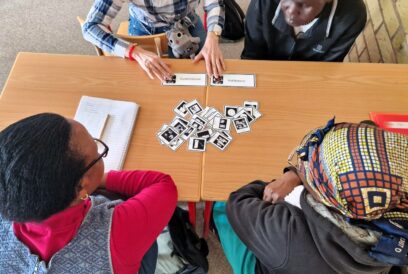

Core learnings from improvisation activities are being more creative, more collaborative, more confident and more responsive to change. Image: Shutterstock
Core learnings from improvisation activities are being more creative, more collaborative, more confident and more responsive to change. Image: Shutterstock
An improv mindset, which professionals of numerous fields train by applying methods from stage improv, helps them to become more observant and cooperative. Facing the unexpected is less stressful with the right attitude and energy.
A group of corporate leaders are walking silently around in a room as they are asked to do. They then greet others with a smile, stop and pay attention to their fellow-walkers.
Reflecting on their own feelings and interpreting those of others feels easier to some. Others are looking confused, one even sceptical. All this might feel a little bit silly and the purpose of it baffling.
Why are we doing this? How does this make me feel? Why? And how on earth is this going improve my leadership skills?
This is one example of how applied improv training for businesses can begin.
“There is always a level of fear of what is going to happen, so I need to start in a very simple and non-challenging way,” explains the trainer of the group, Declan Hannigan.
Hannigan has a science degree but has worked in arts and as a trainer for 12 years. The Hungary-based Irishman teaches communication skills to businesses all over Hungary and in its neighbouring countries.
Max Dickins, a UK improv trainer specialised in corporations agrees. “People might walk into the class with prejudices. It’s my job to relax them and assure them I will not make them look stupid, and that this is not a performance.”
Borrowing from the stage equivalent
Improvisation is indeed better known as a genre of entertainment. Acting and reacting without a script and creating something in the moment has produced endless theatre and television shows worldwide.
Applied improvisation is the term used for simply taking the concepts, ideas and techniques from the world of improvisation and applying them to business, relationships, learning and life.
“The games can be the same but why and how you work with them and how you reflect the exercises is different,” Hannigan explains.
Although we cannot control the world, the energy and attitude we bring to something and how we hold ourselves is under our control.
Core learnings from improvisation activities are being more creative, more collaborative, more confident and more responsive to change. The overarching philosophy of improv is to treat everything as an opportunity, not an obstacle.
“Improv training is preparing for the unprepared. The unexpected is going to happen in our fast-changing complex world. Improv teaches you skills that make you ready when the unexpected happens,” says Dickins.
He sees the benefit of all the employees of a company learning improv. The commonly learned culture of support, the baseline of stage improv, can then be transferred to working life.
“Improvisers face the unexpected all the time, but they are not fearful because they know their teammates have ‘got their back’. When performing on stage, they know that whatever happens, their teammates will support their choices.”

Improv training is preparing for the unprepared. Image: Shutterstock.
The trainer emphasises the energy that affects our mindset and can make us feel more creative, resilient and positive.
“In improv, we train a lot about being aware of the energy level of individuals and of the group. Although we cannot control the world, the energy and attitude we bring to something and how we hold ourselves is under our control.”
Avoiding dry and boring corporate training
So starting with walking and reflecting, in the course of corporate training the leaders or employees are actually brushing up their skills in paying attention to another person, listening, reacting, and having good energy and presence.
Instead of soft skills, Hannigan prefers calling these essential skills. To his kids, he describes his work as ‘training people to be nicer to each other’.
There is more than an idealistic reason behind training ’niceness’. In the business world, improving the communication skills of managers and employees means more effective processes and decision-making. This leads to increased productivity.
Standard corporate training can be very dry and boring, which means those who attend don’t really learn from or enjoy the experience.
For example, as EMEA Director of GTM Enablement at Box Inc. in London, Emily Drew is constantly seeking ways to ‘enable’ her teams to do their jobs better. Some of the key areas she has identified as requiring focus have been communication, presentation skills and storytelling.
As a client of trainer Max Dickins’s company Hoopla Business, she first explored improv in a single three-hour trial class which soon led to a programme of sessions.
“The training has fostered much stronger team alignment across different and within the same teams in my company, which in turn has led to greater collaboration and creativity.”
She describes the training sessions as not just more economical but also engaging and more personally beneficial for the employees, who have reported boosted confidence and finding new and exciting ways to approach their work.
“Standard corporate training can be very dry and boring, which means those who attend don’t really learn from or enjoy the experience. Improv in contrast still focuses on many of the key skills needed to perform in a work environment, but tackles them in a much more interesting way.”
Research brings credibility
Although the learning of improv could probably more easily be adapted and sustained in smaller groups, in the first wave it is the big global corporates such as Google, Unilever, PwC, Amazon and Accenture that have seen the monetary value of effective communication and strong relationships, and have included improv into their training portfolio.
“They most certainly have bigger training budgets, but companies have also noticed that when they get over 100 employees, things get more difficult in terms of communication,” says Hannigan.
These corporates are also more forward-looking and getting ready for change.
The nature of work and the skills required are indeed changing. The Future of Jobs report by the World Economic Forum predicts that ‘human’ skills such as creativity, originality and initiative, critical thinking, persuasion, and negotiation will increase in value, as will attention to detail, resilience and flexibility. Emotional intelligence, leadership, social influence and service orientation will also see a great increase in demand.
Emotional intelligence, leadership, social influence and service orientation will also see a great increase in demand.
The ongoing pandemic has made the pace of change faster and the resultant teleworking sets even higher demands on the communication skills, for example.
While applied improv essentially deals with precisely these skills, the impacts of improv training cannot be straightforwardly measured. This might be the biggest hindrance to the dominance of applied improv as a method of training for future working life.
“When something is easy to measure, it is easier to get paid for,” says Hannigan.
In the past five years, Europe has been catching up with the US in using applied improv. There are more books, more data and more research on the subject, giving it more credibility.
“The University of South Carolina did a study about power poses, concluding that your physicality affects your body chemistry, how you feel and how people perceive you,” Hannigan explains.

The impacts of improv training cannot be straightforwardly measured, which might slow down its popularity in the corporate world. Image: Shutterstock
“I had seen all that happening in improv and we did an exercise that produced the same results, but it is more effective and easier to trust when research has been done on it.”
Despite the possibilities of applying improv research to limitless fields, academic research into applied improvisation is still in its infancy. So far, the majority of published data comes from medical improv training, psychology and pedagogy.
Learning to be more human
Even though their field lacks academic research, the practitioners have their own careers and feedback from students to generate trust in the impact of what they do. Outside the business world, applied improv is extensively used to train, for example, engineers, media workers, teachers, entrepreneurs, humanitarian workers, caregivers, first responders and medical students and practitioners.
For the past 37 years, Patricia Ryan Madson, a Professor Emerita from Stanford University, has taught the same class of improv, first in the improvisation programme she developed and now as part of continuing studies at Stanford.
When serving as the head of the undergraduate acting programme at Stanford in the 1970s, she brought in a tool that would help her students to get in contact with their creative self and their impulses; their ‘humanity’ as Ryan Madson calls it.
Many of the students taking the acting classes were actually business students, engineers or scientists who enrolled to add something to their major studies.
“Very quickly, word got round that improv helped people loosen up, get in touch with their imagination and become more positive. All of a sudden, there was a rush of Stanford students coming to the classes, who were not interested in the acting or theatre part of it.”
Today, at the age of 77, she still has the class filling in no time with a mixture of students from different professions.
“I think there is something to being in a room with an old lady who is saying it’s OK to make that mistake, it’s fine, life is too short, let’s laugh at ourselves. Most of us long to be ourselves and be respected by others while learning how to loosen up and deal with the unexpected.”
People join the class to try to find more courage, to be more empathetic, learn better public speaking skills or just for some fun.

Listening, observation and emotional presence are powerful tools that applied improv can teach. Image: Shutterstock
Having the credibility of being a professor, she does not have to ‘sell her classes’. “I’m not prepared to give a template of what you’ll get out of my class, since I don’t know what you’ll get. It’s up to the students to discover this.”
Instead of teaching certain skills, her classes are about teaching a certain mindset.
“The improviser’s mind helps you to look around, pay attention to what is actually going around, work from where you are and use everything that is available to you. It teaches you to be open instead of prescriptive. Most importantly, it invites us to be human.“
Medical professionals benefitting from improv
One unexpected profession benefitting from the improv mindset are medical doctors. It is not as simple as a brain surgeon saying yes to everything and being happy about making mistakes. Instead, according to Professor Emerita Ryan Madson doctors need improv for those moments when science is uncertain or unattainable.
Improv training could enhance the collaborative skills that physicians working in clinical or research teams require. Listening, observation and emotional presence are powerful tools for seeking deeper connections with patients.
For example, when teaching at the medical school, Ryan Madson has been concentrating on uncovering the people skills of doctors and nurses.
“Most of the medical students were so full of their knowledge that they were not good at listening or picking up non-verbal clues. With an improv mindset, we try to discover how to become more observant, show empathy and kindness and learn how humans behave.”
There is still a certain group of professionals she would like to see locked in a room for a month, learning, listening and yessing. Politicians!
Author







